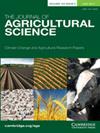Impact of Salinity on the Radiation Use Efficiency of Quinoa (Chenopodium quinoa Willd.) in Semi-arid Area in Tunisia
IF 1.7
4区 农林科学
Q2 AGRICULTURE, MULTIDISCIPLINARY
引用次数: 0
Abstract
The impact of three level of salinity (T0 = 1.2 dS m-1, T1 = 9.2 dS m-1 and T2 = 18 dS m-1) on photosynthetically active radiation intercepted (PARabs), Radiation Use Efficiency at pre-anthesis and post-anthesis (RUEPR and RUEPS), Radiation Use Efficiency of total dry biomass (RUETDM) and Radiation Use Efficiency of Grain Yield (RUEGY) at quinoa harvest were investigated during the growing season (2015). The RUE pre-anthesis (from transplanting to anthesis) has registered a decrease of 10.8 and 15.8% respectively in T1 (RUEPR = 4.62 g MJ-1) and T2 (RUEPR = 4.36 g MJ-1) compared to the control T0 (RUEPR = 5.18 g MJ-1). Likewise, the RUE post-anthesis was reduced by 8.9 and 32.1% in T1 (RUEPS = 1.23 g MJ-1) and in T2 (RUEPS = 0.91 g MJ-1), dissimilarity to T0 (RUEPS = 1.35 g MJ-1). The maximum RUETDM (3.2 g MJ-1) was manifested in (T0). However, the minimum RUETDM (2.8 g MJ-1) was observed in T2 (S = 18 dS m-1). A decline of 16.1% was observed in RUETDM due to the reduction on TDM from T0 (S = 1.2 dS m-1) to T2 (S = 18 dS m-1). As well, the RUEGY declined when salinity increased. The highest RUEGY (1.24 g MJ-1) was registered in T0. However, the lowest RUEGY (0.62 g MJ-1) was obtained in T2. A decrease of 50% in RUEGY due to the height reduction on yield was observed in the T2.盐度对突尼斯半干旱区藜麦辐射利用效率的影响
研究了3个盐度水平(T0 = 1.2 dS - m-1、T1 = 9.2 dS - m-1和T2 = 18 dS - m-1)对藜麦收获期光合有效辐射截截量(PARabs)、花前和花后辐射利用效率(RUEPR和RUEPS)、总干生物量辐射利用效率(RUETDM)和籽粒产量辐射利用效率(RUEGY)的影响。RUE花前(从移栽到开花)T1 (RUEPR = 4.62 g MJ-1)和T2 (RUEPR = 4.36 g MJ-1)较对照T0 (RUEPR = 5.18 g MJ-1)分别下降10.8%和15.8%。同样,花后RUE在T1 (RUEPS = 1.23 g MJ-1)和T2 (RUEPS = 0.91 g MJ-1)分别减少了8.9%和32.1%,与T0 (RUEPS = 1.35 g MJ-1)不同。最大RUETDM (3.2 g MJ-1)出现在(T0)。然而,最小RUETDM (2.8 g MJ-1)出现在T2 (S = 18 dS m-1)。由于TDM从T0 (S = 1.2 dS m-1)减少到T2 (S = 18 dS m-1), RUETDM下降了16.1%。随着盐度的增加,RUEGY也呈下降趋势。第0期RUEGY最高,为1.24 g MJ-1。然而,T2的RUEGY最低(0.62 g MJ-1)。在T2中观察到,由于高度降低对产量的影响,RUEGY降低了50%。
本文章由计算机程序翻译,如有差异,请以英文原文为准。
求助全文
约1分钟内获得全文
求助全文
来源期刊

Journal of Agricultural Science
农林科学-农业综合
CiteScore
2.80
自引率
5.00%
发文量
68
审稿时长
1.4 months
期刊介绍:
The Journal of Agricultural Science publishes papers concerned with the advance of agriculture and the use of land resources throughout the world. It publishes original scientific work related to strategic and applied studies in all aspects of agricultural science and exploited species, as well as reviews of scientific topics of current agricultural relevance. Specific topics of interest include (but are not confined to): all aspects of crop and animal physiology, modelling of crop and animal systems, the scientific underpinning of agronomy and husbandry, animal welfare and behaviour, soil science, plant and animal product quality, plant and animal nutrition, engineering solutions, decision support systems, land use, environmental impacts of agriculture and forestry, impacts of climate change, rural biodiversity, experimental design and statistical analysis, and the application of new analytical and study methods (including genetic diversity and molecular biology approaches). The journal also publishes book reviews and letters. Occasional themed issues are published which have recently included centenary reviews, wheat papers and modelling animal systems.
 求助内容:
求助内容: 应助结果提醒方式:
应助结果提醒方式:


